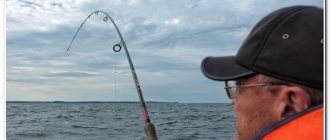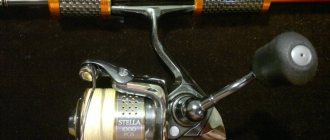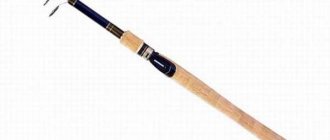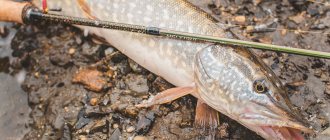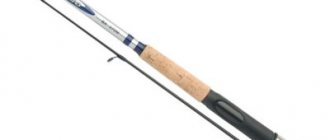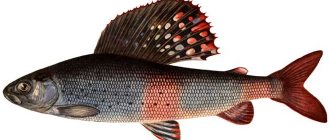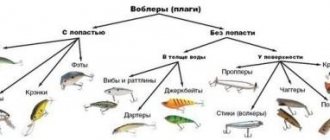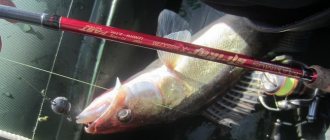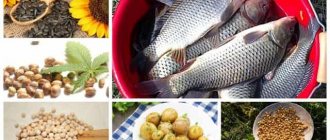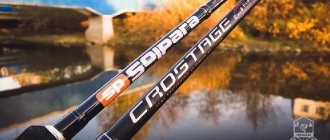I am an avid spinning rod player, and if in the spring the predator’s bite is difficult, then I have a backup, long-proven option - I’ll instantly convert my spinning rod into a feeder and catch leucorrhoea, getting great pleasure from it, since the pike and perch are on strike.
I’m not keen on bottom fishing in summer and autumn, so I don’t have much desire to purchase specialized feeder gear for just a few spring fishing trips. Moreover, a normal 2.7m jig rod with a soft tip and 40g test completely suits me when working with feeders weighing 20-80g, and I haven’t broken anything yet. I don’t encourage you to follow my example, but I will say this – you can foolishly break anything, including even a powerful feeder with a small 20g feeder. When I work with the spinning rod carefully, I don’t cause any problems to it. I’m just not too lazy to check before each cast to see if there is any overlap in the tulip area.
The cast itself is not a short, sharp jig, but a wide, smoothly accelerated one. I always hook it short, because even when the fish is not hooked, I still have to move the feeder along the bottom. And the tip of the rod is not at all hard when fishing in the current, but somewhere there is a lack of sensitivity, so I’ll hang a bell or a simple plumb line, following the example of the zakidushechniks. Plus 0.12 braid on a reel, some 0.12-0.2 fishing line for leashes, a set of feeders, hooks, a stand with a small fish tank, a folding chair, some groundbait - so I’m practically a full-fledged fisherman. Maybe I’m wrong, but, in my opinion, too much attention is paid to feeder equipment; nevertheless, the most important thing is the choice of the right tactics and fishing techniques, and this is what I focus on when searching for fish.
It’s difficult to get rid of spinning “habits” when using feeder fishing, but this is not bad – sometimes it has a positive effect on the results. I often hear that the fisherman must sit out the fish, not twitch, and persistently feed the point. I don’t argue, but in my experience, it is in the spring that the legs feed not only the spinning fisher, but also the milker. On a spring day I can easily walk along the river for about a kilometer, checking each promising place for a maximum of half an hour, and if I don’t find anything interesting, then I move further 50-60 meters. If I don’t see any obvious good places, then, following my jigging habit, I will quickly tap the bottom, finding an interesting “trunk”, an edge where there is no grass, snags and where there is potential for feeding.
I will tap it with a suitable weight so as not to break into spinning fishing. But sometimes I can’t stand it and leave it with a ripper on a jig head - I’ll scout out the place, catch something predatory, if I’m lucky, then I’ll feed.
Spinning habits also affect the active selection of catchable feeder baits. Just as in spinning fishing it is difficult to count on regular success with one or two spoons or rubber bands, in bottom fishing there is no desire to fish only for a worm on a hook or to rely only on a universal, easy-to-use maggot.
Fussing with preparing plant baits is alien to me, but I try to compensate for this laziness with animal baits that I look for in a pond or on the way to fishing - shells, leeches, shitfish, caterpillars, bark beetles, water worms, etc. And I often change different baits, combining them in “sandwiches”, looking for and finding my cherished bite. Plus, I have long been convinced of the effectiveness of artificial baits, making cuttings (in the form of maggots or small shortened worms) from old rippers or twisters. Even ordinary tires worked, and when the “edible” appeared, everything went great, especially for perch and silver bream.
The biggest influence of spinning on feeder fishing was the habit of selecting a catchy line. Of course, in donk its importance is not so great, but it can be significant, giving significantly more fish compared to fishing with a stationary bait. Even the simplest braces can work great - pull it up very slowly a few centimeters, give a pause for a couple of seconds, pull it up again and then another pause.
The main experiments I conduct are not with the pull-up distance, but with pauses, from very short to long, several minutes. On a river current, such pull-ups are especially good when the weight of the feeder is beyond reserve, it can hardly be held at the bottom, and when pulled up, it is slightly carried away in an arc, while the nod straightens. Having convinced himself that this was an interesting technique, he began to complicate such wiring, making the demolition arc longer.
The main thing is that there are no algae at the bottom, and especially no snags. It is also important that the equipment is as simple as possible, not prone to tangling, I assemble it on the basis of a regular spiral, oval sliding feeder, loaded according to the force of the current: I put it on the braid, then a plastic bead - a bumper, I tie a swivel, and a leash with a hook to it.
I cast across the river a little higher upstream, hoping that the feeder will lie on the bottom opposite me, fix the whip in the reel clamp, determining the range, and immediately reel it to the shore. I fill the feeder with food, put on the bait, cast it - the feeder lies on the bottom, and it slowly begins to be pulled in an arc towards the shore, the whip is taut. At some point the drift stops, I pause for a few seconds and reel in the equipment for the next cast. I add food to the feeder and throw it to the starting point, trying not to smear it, noticing a suitable landmark on the other side. After just a few casts, a fed arc is created at the bottom - a path along which I continue to fish.
The length of the arc depends on the weight of the feeder; the lighter it is, the longer the arc, and vice versa. This process is easily adjusted if desired or necessary. While retrieving, I can hold the rod in my hand, but then careful bites are hard to notice at the tip of the rod, it’s good if they give it to the hand, but this doesn’t always happen. It’s safer to put the spinning rod on a high stand after casting, but I don’t take my hand off the butt - I’m always ready for a lightning-fast hook.
lovimvse.ru
What is spinning?
Spinning is the best option for successfully catching fish, especially predatory ones. But in order for there to really be success, spinning requires a certain amount of knowledge and practical skills . It is optimal if, with the purchase of your first spinning rod, you receive information support from a more knowledgeable and experienced fisherman. Further, it is quite possible to “upgrade” the gear independently, without outside help, but basic knowledge is required.
Before you go to a specialized store to make a purchase, you need to delve into the theoretical part and description of the spinning rod itself. It is necessary to understand the principle of its operation, its possible varieties, and study the technologies that are often present in the production process.
Depending on the design, the spinning rod can be telescopic or plug-in. Telescopic rods are better suited for beginner fishermen because they:
- Significantly cheaper than the plug version.
- Lungs.
- Less bulky.
- Folds up great.
- Much more convenient than plug-in ones during operation.
Those who already have significant experience in fishing choose models like feeder gear for the following reasons:
- There is no significant weight at the docking point.
- Excellent elasticity indicators.
- High degree of sensitivity.
- Individual placement of rings.
Depending on the material from which the tackle is made, spinning rods come from:
- Composite.
- Fiberglass.
- Carbon fiber.
There is also a rod construction parameter. It implies the degree of response to external actions. The structure can be:
- Slow (the whole rod bends)
- Medium (half of the rod bends)
- Fast (top bends)
In order to choose the best option, you must first of all have the necessary amount of information and understand the purpose of purchasing gear.
What is a feeder rod?
A type and optimized bottom tackle is considered to be a feeder rod. The main features of the feeder are the presence of a sensitive tip, which instantly reacts to a bite. There is a feeder classification:
- Easy class.
- Middle class. The most popular one is used by professional fishermen and is suitable for beginners.
- Hard class.
- Ultralight class (picker).
- Super heavy class (for fishing in difficult conditions).
Like a spinning rod, a feeder rod is characterized by test indicators . You should not deviate from the test parameters when choosing a form. It is better not to reach the maximum indicator with a margin of 10 g. The feeder rod visually consists of three or four components, and can reach up to 4 meters in length. The tip is always marked with a bright color to attract fish and increase the bite. The length is chosen depending on the place of fishing. The longest ones are designed for fishing in reservoirs or deep and large lakes. For shallow rivers, three-meter feeders are suitable.
Rod build
The structure of a feeder rod when choosing for beginning fishermen should be one of the main parameters. It makes it clear what rigidity (elasticity) the body of the tackle has.
A fast action belongs to a stiff rod. When loaded, only the top and first knee of the product will bend. This action is considered the best when choosing a feeder rod for carp. When the fish goes behind the snags, this quality will allow you to control it during the fishing process.
The slow action allows the rod to bend at all knees, which will prevent the leader from breaking.
And here's what you need to know: Fishing for carp with a feeder, Feeder equipment for carp Video
https://www.youtube.com/watch?v=JWhqzYBJ_7w
To decide how to choose a feeder rod for beginners, you should purchase a product with a complex action. Such a tackle will bend only at the top under light loads, and with strong resistance from a large fish, all its knees will move. This will allow you to determine which feeder rod for carp fishing will be more comfortable for the fisherman.
What is the difference between a spinning rod and a feeder rod?
Feeder and spinning rods are designed for catching fish; they have the same purpose. But, there are significant differences in the methodology and area of their use. Feeder rods and spinning rods are designed for completely different types of fishing. Feeder, after casting you can put it on the stand and wait for a bite. The spinning rod must be held in your hands at all times.
A feeder rod is much heavier and longer than a spinning rod. In addition, fishing with a spinning rod is much more active than when using a feeder. You can change the tips on the feeder, which indicate flexibility and the degree of bite; the spinning rod has no removable parts. What type of gear to choose is a purely individual question, which depends on preferences, type of fish, type of water body and financial capabilities.
vchemraznica.ru
How to use spinning rods for bottom fishing
Carp is very careful. When casting long distances, the use of a feeder feeder is mandatory.
During the fishing process, a fisherman often has to experiment with the type of gear, bait and bait. In the intervals between bites you will have to select different types of baits. The better and more varied they are, the greater the chance of the fisherman not returning home empty-handed.
The warmer the water, the more flavorings should be added to the bait. To catch carp, you should choose reservoirs with sharp changes in depth and uneven bottom topography. Carp like to hide in holes near the bottom. If the bait falls into one of them, there is a high probability that the fisherman will be lucky to pull a large fish ashore.
Having become familiar with all the features that should be taken into account when deciding how to choose a feeder rod, a novice angler will be able to choose the best option. Based on the recommendations of experienced carp fishing experts, there is no doubt in the successful choice of all the necessary gear.
Over time, each carp fisher will select the optimal and comfortable type of gear and will be able to combine them in the best way for existing conditions. Fishing with the right equipment will bring a lot of good mood and unforgettable impressions.
Bottom fishing is consistently popular with many anglers. This type of gear evolved gradually.
At first there were the simplest hooks, then an improvement occurred in the form of adding an elastic band, which made it possible to return the equipment to its place. The next stage was fishing rods with inertia or inertia-free reels, while the feeder can be considered the pinnacle of development.
And here’s what you need to know: Tackle for catching carp - feeder and top, float and bottom (video installation)
For ordinary donkeys, spinning rods with a suitable test range were often used.
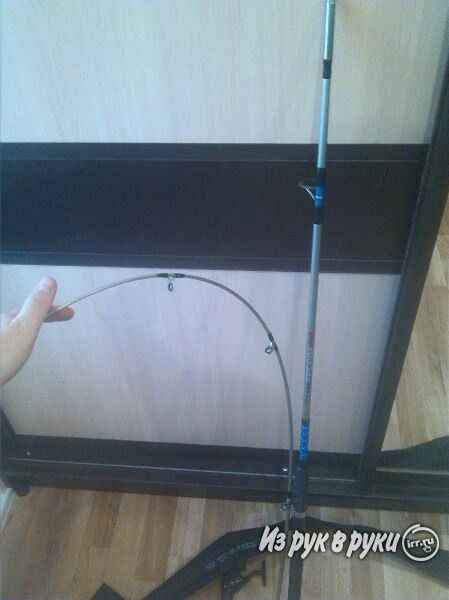
The question of how to make a donkey from a spinning rod still worries many fishermen who want to try a new method of fishing without spending money on specialized gear. Even if the spinning rod is inferior in all respects to the feeder, it is quite suitable for the first step in mastering bottom fishing, but if you are interested in fishing from the bottom, then it makes sense to get a more suitable rod.
Advantages of using a spinning rod as a donkey
Choosing a spinning rod for a feeder
Along with classic spinning fishing, feeder spinning fishing is gaining popularity.
Translated from English, “feeder” means “feeder.” This idea originated in England. Simply put, food is served to the fish in a special feeder. And there the hooks with attachments are already waiting. A modern version of fishing with a feeder is called quivertip. Only special blanks are used, match ones with a very sensitive tip. The latter plays the role of a bite alarm.
There are differences between spinning and feeder forms. Although these differences do not prevent you from fishing with a spinning rod as a feeder, or with a feeder as a spinning rod.
In a spinning rod, the strength and elasticity of the rod should exceed that of float rods. A simple spinning cast is sometimes on the verge of the strength of the tackle material.
Modern rods for spinning tackle are made of carbon fiber and carbon fiber with the addition of boron fibers, which create additional flexibility. The most common products now are made from multilayer composite with the addition of graphite. They have the inscription "CARBON" on them.
What is the difference between a feeder and a spinning rod:
- The feeder rod is quite long, up to 4.5 meters and heavier than the spinning rod. It is used for bottom fishing; after casting, it is fixed in the stand. The spinning rod is held in the hands and the reel is constantly rotated. The length of the feeder is an important indicator; it determines the casting of the feeder over a long distance.
- Feeder forms have the same indicators as spinning forms: test, action, length. They show the weight of the bait, which can be cast without fear of breaking the tip. The structure of the whip is characterized by its convexity under load;
- Spinning rods are much shorter than feeder rods. This was done for ease of throwing. Spinning fishing is active; you have to cast baits of different weights hundreds of times. With a short whip, the angler will not get so tired.
- An important difference between a spinning rod and a feeder is the presence of a tip on the latter. The fisherman feels the bite, this is not the case with a spinning rod. There, holding the fishing rod constantly in his hands, the angler hears the fish hitting the bait.
Vershinki
Special mention must be made about the top. Its sensitivity is measured in ounces. The ounces indicate how hard you need to press the tip of the tip to bend it 90 degrees. The toughest are the 6-ounce ones.
The tips are divided into three degrees of hardness.
- Soft - used in standing water;
- Medium - for fishing in small currents, or in windy weather;
- Hard - used on rivers with strong currents.
The tips do not take part in the throwing process; they transfer the weight of the load to the form. When choosing a tip, you should know the speed of the current and the weight of the feeder being thrown.
In addition to these differences, there are also great similarities between spinning and feeder rods. This concerns the material of manufacture: they are all made of fiberglass and carbon fiber. Composite materials (graphite and fiberglass) are also used. And the most modern materials for the manufacture of spinning and feeder rods are carbon.
For successful feeder fishing, an angler must know all the accessories for such fishing. Feeders can be factory-made or home-made. Its role is to deliver food to the place where the fish are located. It is both a bait for bottom inhabitants and a place for them to feed.
Main differences
By fishing method
Spinning fishing is fundamentally different from feeder fishing. The latter is much calmer and unhurried, most of the time the tackle rests peacefully on the stand, waiting for a bite, and casts occur mainly when a new portion is delivered to the feeding area.
Spinning fishing is entirely based on constant casting and retrieving; there is no room for expectations or doubts. The entire fishing process, not just hooking and fishing, depends on the activity of the fisherman.
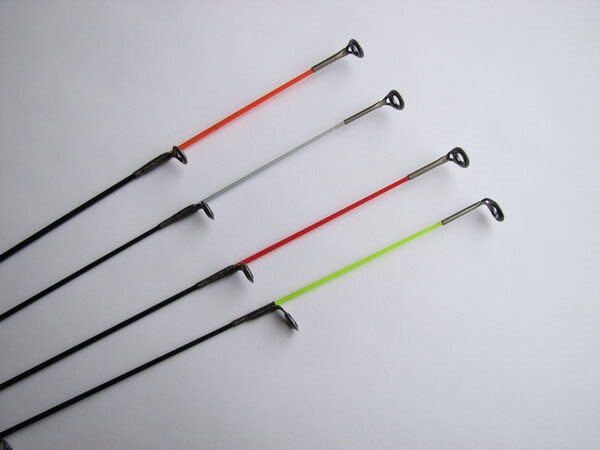
The detection of bites in feeders occurs thanks to a special rod tip - a quivertip. The quivertip is very flexible and sensitive; observing its movement allows you to determine the moment of a bite.
With a spinning rod, due to the design of the rod, the detection of a bite occurs due to the vibrations of the entire tackle that the fisherman holds in his hand, that is, the bite is felt by the fisherman not visually, but tactilely.
The sensitivity of a quivertype is expressed in ounces. It is equal to the number of ounces required to bend the quiver tip 90°. The lower this number, the more mobile the tip. The “tightest” tips have a sensitivity of 6.
Also, the tips differ in rigidity:
- soft ones are used in standing water;
- medium ones are used for minor currents or low winds;
- rigid ones are used in reservoirs with strong currents.
Therefore, depending on the conditions and the object of fishing, when using a feeder, you should have with you a set of tips with different sensitivity and rigidity.
Which feeder to choose?
- Bait - for primary feeding of fish, attracting them to the fishing spot. Holds a large volume of feed, has large holes for its quickest rinsing;
- Feeder for long-distance casting - similar to a badminton shuttlecock, good for casting to the right place;
- Supplementary feeding - good in still water and in currents, has different cells for slowly washing out the feed. Its task is to keep the fish in one place for a long time.
Choice of bait
The success of feeder fishing depends on well-chosen bait. The bait is based on various cereals and cakes. They also add aromas and worms. Each fisherman has his own secrets for preparing bait.
The feeder is filled at the fishing site and always with fresh food. An exception may be fishing for carp, which is called “water pig” because of its omnivorous nature. Throw a feeder with hooks attached to it to a possible location of fish. Fixed on a stand at an angle to the plane of the water. This makes it more convenient to watch the moment of the bite.
One of the disadvantages of feeder fishing is frequent baiting. This reduces the actual fishing time. To solve this problem, feed is delivered in another way (by hand, slingshot). It became possible to use a form without a feeder, with a lighter structure. This is how light-weight picker rods with large dough appeared. There was also a spinning rod here. Picker from a spinning rod has become available to many homemade fishermen.
Is there a significant difference between a spinning rod and a feeder?
Both the spinning rod and the feeder are designed equally for successfully catching fish, especially predatory ones. In order for it to be successful, you must have some knowledge and practical skills in this gear.
Test
When purchasing a spinning rod, you do not need to deviate from these parameters. When planning a spinning fishing trip with a feeder, you need to choose a spinning rod with a safety margin. This gear is designed for fishing from the bottom.
Build
Both spinning rods and feeder forms have their own structure. The longer the whip, the higher the action indicator. These rods are suitable for long casting on lakes.
Feeders are also distinguished by a large number of passage rings; they provide the load evenly along the entire length of the form.
Apex (quivertype)
A distinctive feature of the feeder from a conventional spinning rod is the presence of replaceable tops. They signal the fisherman about a bite. Usually 3-4 tops are supplied with the feeder.
This element has its own test. The color indicates the stiffness of the quivertype. The red top is the stiffest, the orange or hard top has medium flexibility, and the green top is the softest.
The type of top is selected in accordance with the conditions of the reservoir. If the current is strong, you should choose rigid quivertips. The soft elements of the rod will be able to more accurately convey the signal of a bite in calm water without waves or currents.
And here's what you need to know: Fishing hooks for wobblers and spinners
If the quivertype breaks due to an accidental impact or severe bending, you can pick up an identical product in the store. When choosing, you should take into account the diameter of the base. It must correspond to the value specified by the manufacturer.
